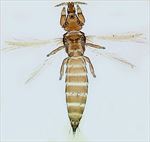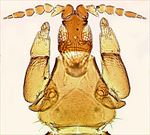
mexicanus female

mexicanus male

mexicanus head, pronotum, antenna

mexicanus mesonotum-tergite II

mexicanus fore wing
Generic diagnosis
Female macropterous. Head smaller than pronotum, prolonged in front of eyes, with three or more pairs of stout ocellar setae on anterior prolongation; maxillary palps 3-segmented; eyes large; four pairs of postocular setae. Antennae 8-segmented, segment I enlarged, without paired dorso-apical setae, II strongly projecting laterally with stout seta at apex, III and IV with sense-cone simple. Pronotum with posterior margin wider than anterior margin, with two pairs of weak posteroangular setae; usually four pairs posteromarginal setae. Mesonotum with median pair of setae far from posterior margin, anterior campaniform sensilla present. Metanotum with median pair of setae medially; campaniform sensilla present. Fore wings slender, first vein with long gap in setal row and two setae apically; second vein with four irregularly arranged setae; clavus usually with four veinal and one discal setae; posterior fringe cilia wavy. Prosternal ferna divided; basantra without setae, weakly sclerotized and fused with ferna; prospinasternum eroded medially. Mesosternum with sternopleural sutures reaching anterior margin; endofurca without spinula, furcal invaginations widely separated. Metasternal endofurca without spinula. Fore tibia with ventral outer margin often prolonged. Tarsi 2-segmented. Tergites without ctenidia; I–VIII with broad craspeda; tergite IX usually with two pairs of campaniform sensilla, MD setae small; X with median split complete. Sternites without discal setae or craspeda; sternites III–VII with three pairs of posteromarginal setae, II with two pairs, sternite VII with S1 setae at posterior margin.
Male apterous, smaller than female; ocelli absent; sternites III–VII each with a large round pore plate.
Biological data
All species of Arorathrips and Chirothrips breed within grass flowers, with each larva pupating separately within a single developing caryopsis. Larvae of species in these two genera have reduced legs, and presumably cannot move between individual flowers.
Distribution data
The members of this genus are all endemic to the New World (Nakahara & Foottit, 2012), but mexicanus is now widespread and likely to be found throughout the tropics and subtropics.
Nomenclatural data
Arorathrips Bhatti, 1990: 194. Type species Chirothrips mexicanus Crawford 1909, by original designation.
The 16 species recognised in this genus (ThripsWiki, 2020) presumably all came originally from the Americas. Only one species is recorded from China, and this is widespread in sub-tropical countries.
mexicanus (Crawford DL, 1909: 114). (Chirothrips)
Relationship data
Thripidae sub-family Thripinae: this is a diverse group involving more than 230 genera. This genus is closely related to the more widespread genus Chirothrips, but the species of Arorathrips all have the mesosternal furca weakly developed, with the sternal furcal invaginations widely separated. The ovipositor is more weakly serrate than in typical Thripinae.
References
Nakahara S & Foottit RG (2012) Review of Chirothrips and related genera (Thysanoptera: Thripidae) of the Americas, with descriptions of one new genus and four new species. Zootaxa 3251: 1–29.
ThripsWiki (2020) ThripsWiki - providing information on the World's thrips. <http://thrips.info/wiki/Main_Page>